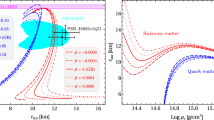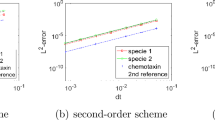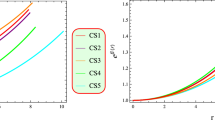Abstract
Establishing and successfully implementing new numerical computational technique(s) with simulation tool is one of the most important difficult tasks in order to carry out real time scientific astronomical and other sophisticated problems. The main focus and highlight of this paper is concerned with the introduction of a newly proposed simple embedded RKAHeM(4,4) technique to determine the distribution of thermodynamic variables inside protoplanets during pre-collapse stage, formed by gravitational instability, for protoplanetary masses between 0.3 to 10 Jupiter masses. The case of convection is a significant concern for transference of heat inside the protoplanet and the graphical solution demonstrates positively better performance by inducting the newly proposed effective RKAHeM(4,4) algorithm for any length of time in comparison with the results through Classical Runge–Kutta method. Furthermore, the analytic expression for local truncation error, global truncation error and error estimates are derived for better understanding. A viable quantitative analysis has been carried out to clearly visualize the goodness and robustness of the proposed RKAHeM(4,4) algorithm.



Similar content being viewed by others
References
Bader M (1987) A comparative study of new truncation error estimates and intrinsic accuracies of some higher order Runge-Kutta algorithms. Comput Chem 11:121–124
Bader M (1998) A new technique for the early detection of stiffness in coupled differential equations and application to standard Runge–Kutta algorithms. Theor Chem Acc 99:215–219
Bodenheimer P, Grossman AS, DeCampli WM, Marcy G, Pollack JB (1980) Calculations of the evolution of the giant planets. Icarus 41:293–308
Boley AC, Hayfield T, Mayer L, Durisen RH (2010) Clumps in the outer disk by disk instability: why they are initially gas giants and the legacy of disruption. Icarus 207:509–516
Boss AP (1997) Giant planet formation by gravitational instability. Science 276:1836–1839
Boss AP (1998) Evolution of the solar nebula. IV. Giant gaseous protoplanet formation. Astrophys J 503:923–937
Boss AP (2002) Evolution of the solar nebula. V. Disk instabilities with varied thermodynamics. Astrophys J 576:462–472
Boss AP (2007) Testing disk instability models for giant planet formation. Astrophys J 661:L73–L76
DeCampli WM, Cameron AGW (1979) Structure and evolution of isolated giant gaseous protoplanets. Icarus 38:367–391
Durisen RH, Boss AP, Mayer L, Nelson AF, Quinn T, Rice WKM (2007) In: Reipurth VB, Jewitt D, Keil K (eds) Protostars and planets. University of Arizona Press, Tucson, p 607
Evans DJ, Yaakub AR (1995) A new Runge–Kutta RK(4, 4) technique. Int J Comput Math 58:169–187
Evans DJ, Yaacob N (1995) A fourth order Runge–Kutta method based on the Heronian Mean formula. Int J Comput Math 58:103–115
Helled R, Schubert G (2008) Core formation in giant gaseous protoplanets. Icarus 198:56–162
Helled R, Bodenheimer P (2011) The effects of metallicity and grain growth and settling on the early evolution of gaseous protoplanets. Icarus 211:939–947
Hubickyj O, Bodenheimer P, Lissauer JJ (2005) Accretion of the gaseous envelope of Jupiter around a 5–10 Earth-mass core. Icarus 179:415–431
Lambert JD (1973) Computational methods in ordinary differential equations. Wiley, New York
Lambert JD (1980) Computation techniques for ordinary differential equations. In: Sayers DK (ed) Gladwell I. Academic, London, pp 19–46
Lotkin M (1951) On the accuracy of RK methods. MYAC 5:128–132
Mayer L, Quinn T, Wadsley J, Stadel J (2002) Formation of giant planets by fragmentation of protoplanetary disks. Science 298:1756–1759
Mayer L, Quinn T, Wadsley J, Stadel J (2004) The evolution of gravitationally unstable protoplanetary disks: Fragmentation and possible giant planet formation. Astrophys J 609:1045–1064
Nelson AF, Benz W, Ruzmaikina TV (2000) Dynamics of circumstellar disks. II. Heating and cooling. Astrophys J 529:357–390
Paul GC, Pramanik JN, Bhattacharjee SK (2008) Structure of initial protoplanets. Int J Mod Phys A 23:2801–2808
Pollack JB, Hubickyj O, Bodenheimer P, Lissauer JJ, Podolak M, Greenzweig Y (1996) Formation of the giant planets by concurrent accretion of solids and gas. Icarus 124:62–85
Ponalagusamy R, Senthilkumar S (2009) A New Fourth Order Embedded RKAHeM(4,4) Method with Error Control for Multilayer Raster Cellular Neural Network. SIVP 3:1–11
Ponalagusamy R, Senthilkumar S (2011) Investigation on Time-Multiplexing Cellular Neural Network Simulation by RKAHeM(4,4) Technique. IJAIP 3:43–66
Ralston RH (1957) Runge–Kutta methods with minimum error bonds. Math Comput 16:431–437
Rice WKM, Armitage PJ, Bate MR, Bonnell IA (2003) The effect of cooling on the global stability of self-gravitating protoplanetary discs. MNRAS 339:1025–1030
Senthilkumar S (2009) New Embedded Runge–Kutta Fourth order Four Stage Algorithms for Raster and Time-Multiplexing Cellular Neural Networks Simulation, Ph.D. Thesis, Department of Mathematics, National Institute of Technology [REC], Tiruchirappalli,Tamilnadu, INDIA
Shampine LF, Gordon MK (1975) Computer solution of ordinary differential equations-the initial value problem. W.H. Freeman & Co, San Francisco
Yaakub AR, Evans DJ (1999) A fourth order Runge–Kutta RK(4, 4)method with error control. Int J Comput Math 71:383–411
Acknowledgements
The first author would like to extend his sincere gratitude to Government of India, eternally for providing financial support during doctoral studies via Technical Quality Improvement Programme (TEQIP), Under Ministry of Human Resource Development, to National Institute of Technology [REC], Tiruchirappalli-620 015, Tamilnadu, India. URL:http://www.nitt.edu. Further, the author expresses his grateful thanks to Government of Malaysia for offering financial grants during post doctoral fellow scheme to Universiti Sains Malaysia [An Apex Public University by Government of Malaysia], School of Mathematical Sciences, Pulau Pinang-11800, Penang, Malaysia. URL:http://www.usm.my. The second author wishes to thank Professor Shishir Kumer Bhattacharjee, Department of Mathematics, University of Rajshahi, for discussions during the time this manuscript was being prepared. The authors also would like to thank the anonymous referees for comments and suggestions that helped us to improve the quality of the manuscript.
Author information
Authors and Affiliations
Corresponding author
Additional information
Communicated by: H. A. Babaie
Rights and permissions
About this article
Cite this article
Senthilkumar, S., Paul, G.C. Application of new RKAHeM(4,4) technique to analyze the structure of initial extrasolar giant protoplanets. Earth Sci Inform 5, 23–31 (2012). https://doi.org/10.1007/s12145-011-0093-4
Received:
Accepted:
Published:
Issue Date:
DOI: https://doi.org/10.1007/s12145-011-0093-4




